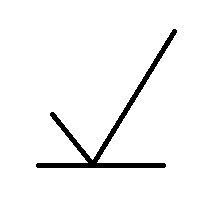 | ||
Surface roughness often shortened to roughness, is a component of surface texture. It is quantified by the deviations in the direction of the normal vector of a real surface from its ideal form. If these deviations are large, the surface is rough; if they are small, the surface is smooth. In surface metrology, roughness is typically considered to be the high-frequency, short-wavelength component of a measured surface. However, in practice it is often necessary to know both the amplitude and frequency to ensure that a surface is fit for a purpose.
Contents
- Parameters
- Profile roughness parameters
- Amplitude parameters
- Slope spacing and counting parameters
- Bearing ratio curve parameters
- Fractal theory
- Areal roughness parameters
- Practical effects
- References
Roughness plays an important role in determining how a real object will interact with its environment. In tribology, rough surfaces usually wear more quickly and have higher friction coefficients than smooth surfaces. Roughness is often a good predictor of the performance of a mechanical component, since irregularities on the surface may form nucleation sites for cracks or corrosion. On the other hand, roughness may promote adhesion.
Although a high roughness value is often undesirable, it can be difficult and expensive to control in manufacturing. Decreasing the roughness of a surface usually increases its manufacturing cost. This often results in a trade-off between the manufacturing cost of a component and its performance in application.
Roughness can be measured by manual comparison against a "surface roughness comparator" (a sample of known surface roughness), but more generally a surface profile measurement is made with a profilometer. These can be of the contact variety (typically a diamond stylus) or optical (e.g.: a white light interferometer or laser scanning confocal microscope).
However, controlled roughness can often be desirable. For example, a gloss surface can be too shiny to the eye and too slippery to the finger (a touchpad is a good example) so a controlled roughness is required. This is a case where both amplitude and frequency are very important.
Parameters
A roughness value can either be calculated on a profile (line) or on a surface (area). The profile roughness parameter (Ra, Rq,...) are more common. The area roughness parameters (Sa, Sq,...) give more significant values.
Profile roughness parameters
Each of the roughness parameters are calculated using a formula for describing the surface. Standard references that describe each in detail are Surfaces and their Measurement.
There are many different roughness parameters in use, but
Since these parameters reduce all of the information in a profile to a single number, great care must be taken in applying and interpreting them. Small changes in how the raw profile data is filtered, how the mean line is calculated, and the physics of the measurement can greatly affect the calculated parameter. With modern digital equipment, the scan can be evaluated to make sure there are no obvious glitches that skew the values.
Because it may not be obvious to many users what each of the measurements really mean, a simulation tool allows a user to adjust key parameters, visualizing how surfaces which are obviously different to the human eye are differentiated by the measurements. For example,
By convention every 2D roughness parameter is a capital R followed by additional characters in the subscript. The subscript identifies the formula that was used, and the R means that the formula was applied to a 2D roughness profile. Different capital letters imply that the formula was applied to a different profile. For example, Ra is the arithmetic average of the roughness profile, Pa is the arithmetic average of the unfiltered raw profile, and Sa is the arithmetic average of the 3D roughness.
Each of the formulas listed in the tables assume that the roughness profile has been filtered from the raw profile data and the mean line has been calculated. The roughness profile contains
Amplitude parameters
Amplitude parameters characterize the surface based on the vertical deviations of the roughness profile from the mean line. Many of them are closely related to the parameters found in statistics for characterizing population samples. For example,
The roughness average,
Slope, spacing, and counting parameters
Slope parameters describe characteristics of the slope of the roughness profile. Spacing and counting parameters describe how often the profile crosses certain thresholds. These parameters are often used to describe repetitive roughness profiles, such as those produced by turning on a lathe.
Other "frequency" parameters are Sm,
Bearing ratio curve parameters
These parameters are based on the bearing ratio curve (also known as the Abbott-Firestone curve.) This includes the Rk family of parameters.
Fractal theory
The mathematician Benoît Mandelbrot has pointed out the connection between surface roughness and fractal dimension.
Areal roughness parameters
Areal roughness parameters are defined in the ISO 25178 series. The resulting values are Sa, Sq, Sz,... Many optical measurement instruments are able to measure the surface roughness over an area. Area measurements are also possible with contact measurement systems. Multiple, closely spaced 2D scans are taken of the target area. These are then digitally stitched together using relevant software, resulting in a 3D image and accompanying areal roughness parameters.
Practical effects
In terms of engineering surfaces, roughness is considered to be detrimental to part performance. As a consequence, most manufacturing prints establish an upper limit on roughness, but not a lower limit. An exception is in cylinder bores where oil is retained in the surface profile and a minimum roughness is required.
Roughness is often closely related to the friction and wear properties of a surface. A surface with a large
